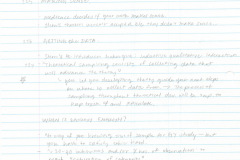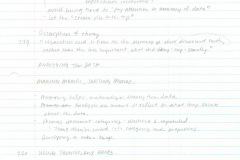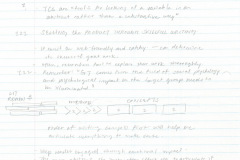
Phyllis Noerager Stern
May 8, 2020
- This paper shares practical advice and tips on performing GT
- (115) Stern emphasizes the importance of making sense; developed theory must comes from data and not forced into an existing framework
Getting the Data
- (116) Stern introduces technique: inductive qualitative interaction
- (117) “Theoretical sampling consists of collecting data that will advance the theory”
- Let your developing theory guide your next steps on where to collect data from. The process of sampling throughout theoretical development will be important to keep track of and articulate
When is Enough Enough?
- There’s no way of knowing size of sample for GT study, but you have to come up with a number to satisfy ethics board
- Example: I plan to conduct ~20-30 interviews and/or x hrs. of observation to reach “saturation of categories”
- “Saturation is reached when the learner hears nothing new”; when nothing is surprising anymore
Worrisome Accuracy
- (118) Glaser claims taped interviews invade GT because it forces researchers to focus on the content more than the concepts and hypotheses that can be drawn from it
- Is this true? Is this more suitable for experienced researchers?
- Tip: Avoid being forced to “pay attention to accuracy of data”, let the “cream rise to the top”
- (119) Description does not lead to theory — “researchers need to focus on the accuracy of their discovered truth, rather than the less important what-did-they-do-exactly”
Making Memos, Sorting Memos
- Memoing helps materialize theory from data
- Analysts use memos to reflect on what they think about the data
- Memos document categories clustered and expanded, then they are sorted into categories and properties
- Developing a rubric map
Using Technology Props
- (120) Glaser is against computer processing — sorting is a creative activity
- Glaser claims, “hand-sorting releases the creativity necessary to see a TC [theoretical code] in the memos, as the analyst constantly compares and asks where each memo goes for the best fit.”
- How can I express my coding process through paper art?
Theoretical Code
- (120) “specify possible relationships between categories you have developed”
- What does this theoretical code look like? Confusing…
- TCs are “tools for looking at a variable in an abstract rather than a substantive way”
Selling the Product Through Skillful Writing
- (121) The title of your paper must be web-friendly and catchy—this can determine the success of your work
- Often, researchers fail to explain their work thoroughly
- (122) Remember: “GT comes from the field of social psychology and psychological impact on the target group needs to be illuminated”
- When writing the final paper, (1) begin describing the concepts you found, (2) walk through the methods you used to collect the data and analysis, and lastly (3) discuss the literature review. This order will help you make sure all pieces are coherent with each other and the origins of your concepts are clear
- Keep reader engaged through emotional impact
- The more abstract, the more effort is required to articulate it
The Figure
- (122) The figure diagram is just a visual guide to the written work; don’t rely on readers to actually understand your findings through the diagram
Murky Writing is Standard English
- If you’re going to use jargon, make sure to clearly define the words you use
- Your paper should make sense to a bright high school senior (grade 12)
On the Shoulders of Giants
- Situate your work within a body of related literature (ex. Kou, Gray, Glaser are also standing on shoulders of giants)
- Show how your work ADDS a NEW dimension to previous work; not about verifying your topic only
- I should feel thrilled throughout the research process



